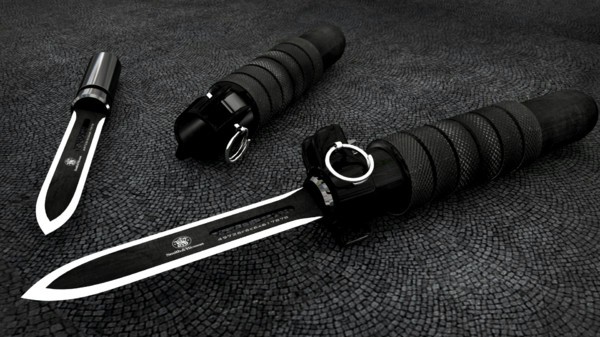


A ballistic knife has a removable blade that ejects from the handle with the press of a trigger. The knife’s name refers to the blade flying way from the knife when triggered. The blade becomes its own projectile. This is why some people consider the ballistic knife to be a firearm.
The detachable blade that can be ejected by pressing a trigger or operating a lever on the handle. The blade completely separates from the handle during firing, unlike a switchblade which simply extends.
This weapon looks like a regular fixed blade knife from the outside. The handle contains a hollow chamber that houses the propulsion system.
Most ballistic knives measure between 4-8 inches in blade length. The handle must be thick enough to contain the propulsion mechanism while remaining comfortable to grip. Spring-powered ballistic knives first appeared in Soviet and Eastern Bloc forces in the 1970s.
The blade design differs from a standard dagger or knife. It features a specially designed tang that allows clean separation from the handle during launch.
| Propulsion Type | Velocity | Range | Advantages | Disadvantages |
|---|---|---|---|---|
| Spring mechanism | 18-25 m/s | 3-5 meters | Quiet, reliable | Limited power |
| Compressed gas | ~30 m/s | 7-8 meters | Higher velocity | Weather dependent |
| Explosive charge | 40-50 m/s | 8+ meters | Maximum power | Loud, complex |
Ballistic knives have a detachable blade that can be ejected several meters by pressing a trigger or operating a lever on the handle. The blade launches using springs, compressed air, or gas propulsion systems. When fired, the blade can travel up to 16 feet at speeds of 39 mph.
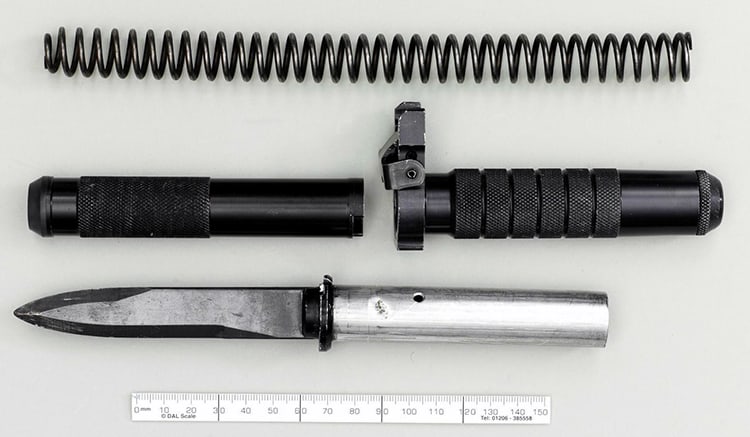
Spring-operated mechanisms are the most common propulsion system. A tightly wound coil spring stores 20-30 joules of energy within the handle. When released, this spring launches the blade at speeds of 18-25 meters per second.
Spring-based ballistic knives are more accurate and generally quieter. However, they still lack precision. The spring also experiences more wear.
The mechanism for ejecting the blade from a spring-based ballistic knife is composed of four key parts: a hollow handle, a removable blade, a spring, and a trigger. The spring is located inside the handle. The trigger is usually in the form of a lever or switch, located on the outside of the handle. The blade is then fitted into the handle and locked into place.
The blade remains locked inside the handle until the trigger is pressed. When this happens, the spring propels the blade forward, releasing it from the knife. The blade is ejected forward, sometimes for several yards.
Gas propulsion systems use compressed CO₂ cartridges borrowed from air guns. These systems can achieve higher velocities around 30 meters per second but require cartridge refills and perform poorly in cold weather.
Air compression and gas propelled knives tend to last longer since the spring experiences less wear over time. The blade has a less accurate aim when fired, though.
Explosive charges with blank cartridges have been used in experimental designs . These achieve the highest speeds of 40-50 meters per second but create significant recoil and noise. The explosive charge method requires additional components like firing pins and blast baffles.
Russian ballistic knives are especially lethal. They are triggered by pulling a pin or pressing a button. The blade stays attached to the handle once deployed, allowing it to be reloaded over and over again. This version of the ballistic knife features a powerful spring that can propel the blade up to 20 feet.
The Russian knife is based on the NRS-2 Gun Hybrid. This weapon combines a knife blade and a single-shot gun that fires a 7.62 mm SP-4 cartridge. The NRS-2 was manufactured in large numbers during the 1980s and it is still used by Russia’s elite Spetsnaz troops.
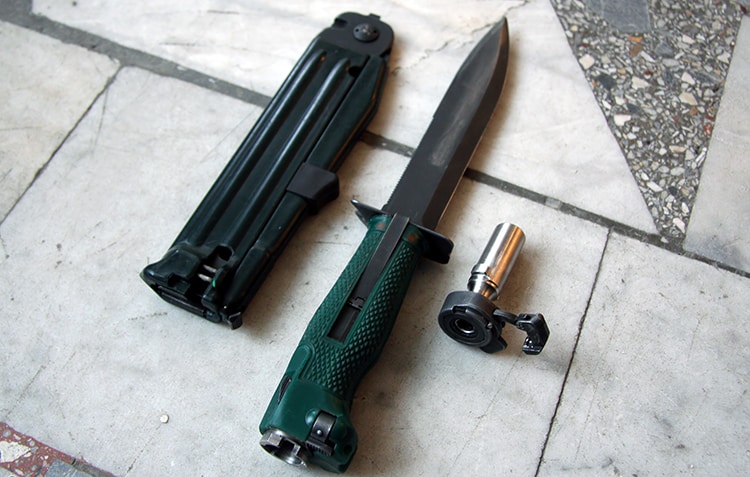
The detachable blade design needs precise engineering to ensure proper separation and flight stability. The blade tang features shallow rails that guide it through the launch tube. These rails must keep tight tolerances within hundredths of a millimeter.
The removable blade lacks fins or spin stabilization once airborne, so accuracy drops beyond close range. Most blades are made from magnetic stainless steel like 440 or 5Cr for corrosion resistance.
The blade must fit perfectly within the handle’s bore. Any misalignment causes side loading that reduces velocity and accuracy. The blade carrier system in gas-powered versions uses a plastic or bronze sabot that separates after launch.
To reload, the user inserts the blade tip-first into a protective sleeve, then pushes the blade back into the handle until the locking mechanism clicks into place.
The locking mechanism in the Ballistic Knife acts as both a safety catch and firing trigger. Most designs use a small cam or side button machined from hardened tool steel. This component must withstand repeated launch forces without deforming.
Safety systems usually include a positive cross-bolt or rotating collar that blocks the firing button. Well-designed models produce an audible click when the safety engages. This sound provides important feedback during high-stress situations.
The sear mechanism holds the compressed spring under over 150 pounds of force. This component needs precise heat treatment to prevent failure. Poor quality sears can cause accidental discharge or system failure.
Cocking the weapon takes significant thumb strength to compress the main spring. The user must push the blade fully into the handle until the sear catches. Using a solid surface for leverage helps with proper cocking.
Ballistic knives first appeared in Soviet military circles during the late 1970s before spreading to commercial markets in the 1980s. Governments quickly imposed strict regulations due to safety concerns and the threat these knives posed to law enforcement.
The United States banned interstate commerce of ballistic knives in 1986 through the Ballistic Knife Prohibition Act. This law prohibits manufacturing, selling, or transporting ballistic knives across state lines.
Federal law has exceptions for military and law enforcement agencies. Individual states have their own additional restrictions. Some states allow ownership but ban carry, while others prohibit possession entirely. Some states also provide exemptions for collectors or educational purposes.
Senator Al D’Amato introduced the prohibition act in April 1986 after demonstrations suggested ballistic knives could threaten body armor. Lawmakers heard concerns about a concealable projectile that might endanger law enforcement officers.
The timing coincided with broader knife legislation targeting dangerous knives during the 1980s. Mail-order catalogs marketed ballistic knives as ultimate survival edges, but Capitol Hill viewed them as public safety threats.
Commercial availability ended when the 1986 prohibition passed. Other countries quickly echoed the ban, causing the commercial market to disappear almost entirely.
The ballistic knife definition usually covers any knife with a detachable blade propelled by springs, gas, or other mechanisms. Fixed blades that cannot be ejected are not included in these restrictions.
Most countries treat ballistic knives like switchblades and throwing stars. Civilian ownership remains illegal in most places without rare military or police exemptions:
Ballistic knives raise many questions about their mechanics, legal status, and market value. Most people want to understand how the spring-loaded mechanism works and why these knives face strict regulations in different countries.
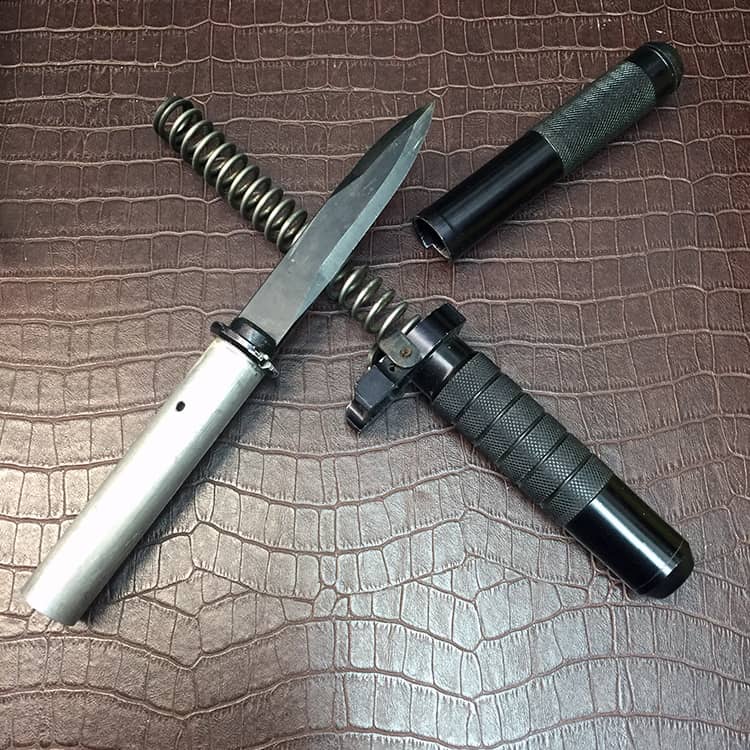
Soviet special forces reportedly used spring-propelled knives in the late 1970s. The famous KGB ballistic knife label was mostly a marketing myth from the 1980s.
Most Russian units actually used the NRS-2 “scout firing knife” introduced in 1986. This weapon fired cartridges instead of launching its blade.
Period Soviet documents provide little information about actual military use. Museum pieces and declassified photos show that prototype development happened.
The Spetsnaz connection gained popularity in Western media and marketing. This association increased commercial interest before the 1986 ban.
In the mid-1980s, the ballistic knife was being sold in the US. Its reputation as a Soviet weapon used for killing and debilitating raised concerns with American authorities. This knife was then banned in 1986.
This ban covers all types of ballistic knives, including those propelled by spring, gas, or air. Knives powered by gas and air compression are considered especially dangerous since they can propel the blade further and sometimes use an explosive charge to do so.
Buyers should check both federal and state laws before attempting any purchase. Possession laws vary significantly between jurisdictions.
Online sales of ballistic knives face heavy restrictions due to federal interstate commerce laws. Most legitimate dealers cannot legally ship ballistic knives to consumers. Some sellers offer replica or non-functional versions for display purposes. These models usually have welded or permanently attached blades.
Law enforcement agencies can purchase functional models through authorized military and police suppliers. These transactions require proper credentials and documentation.
Original collectible models command high prices because they are rare and face legal restrictions. Vintage pieces can sell for several hundred to thousands of dollars.
Authentic Soviet prototypes and original Pilum knives appear mainly at estate sales and specialty auctions. Their value rises because they are scarce and historically significant.
Non-functional replicas and display models cost much less, usually ranging from $50 to $200 depending on quality. Legal restrictions make these knives very hard to find. Most sales happen through specialized collectors and auction houses.
Originally, a ban made in New York State after claims the knife could pierce police body armor. While this bill failed to pass, it was soon followed by others that succeeded. A federal law was passed which banned the possession, manufacture, sale, and importation of ballistic knives.
The law has two key exceptions:
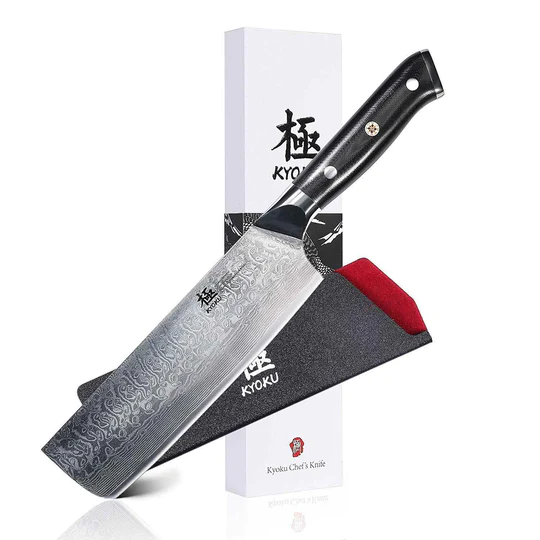
Knife Buzz offers independent product reviews on a wide range of knives used in the kitchen, home, and outdoors. We make it easy for you to find the right knife at the best price.